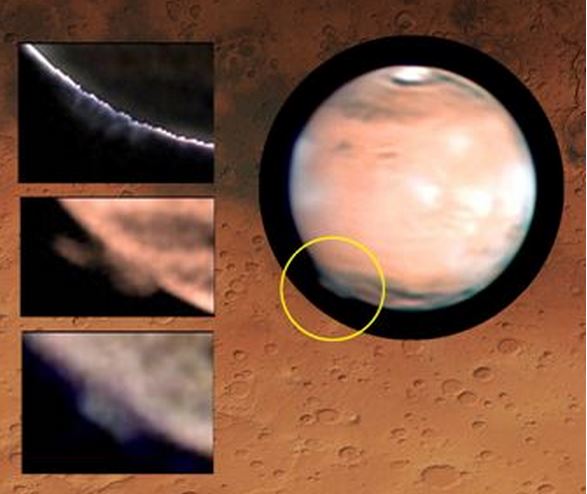A huge bulge, the highest cloud-like plume ever observed, was spotted above the “terminator” of Mars, the boundary between day and night on the Red Planet. Scientists could not understand how something so big and high could appear on the Red Planet’s very thin atmosphere.
Several astronomers in different corners of the world in 2012 gathered images of a plume emerging at dawn on the edge of the disc of Mars.
Spacecraft orbiting Mars have often captured images of thin cloud layers, but none of them exceeding an altitude of 100 km. This bulge, however, was more than 200 km high and was visible for around ten days, but only during the Martian sunrise.

Amateur astronomers were amazed to see such a massive plume so high above Mars’ surface. (Image: University of the Basque Country)
Scientists, with the current knowledge they have about Mars’ high atmosphere, cannot explain this bulge, which could pose problems for future low-orbit missions to Mars.
The research, written by scientists at the University of the Basque Country in Bilbao, Spain, has been published in the academic journal Nature (citation below).
In Mars’ dry, cold, thin atmosphere, the winds blow up the dust from the surface to an altitude of approximately 50 kilometers.
Crystallites are formed in its core thin clouds of ice and carbon dioxide. They are the main component of Mars’ atmosphere, which can on occasions, reach altitudes of up to about 100 km.
Satellites orbiting the Red Planet have taken pictures of the suspended dust and high clouds above its limb or edge projected against the dark background of the sky.
In March and April 2012, when Mars moved closer to the Earth, amateur astronomers worldwide equipped with their high-resolution cameras and telescopes captured detailed images of the planet.
Astronomers worldwide captured images of the high plume
They were amazed to find a high plume on the edge of the disc, above the “terminator’, emerging during the Martian sunrise (dawn).
The University of the Basque Country wrote on its website:
“The bulge was observed rotating with the planet above the limb for about ten days in March, which unequivocally confirmed its presence. Strangely enough, after various days without being spotted, it was possible to see it once again for several days in April.”
By analyzing some of the best images, the scientists have measured this plume that appeared in the Terra Cimmeria, a Martian region, and have developed a geometrical model to account for its visibility.
The team confirmed that the plume was about 500 km wide and reached an incredible altitude of between 200 km and 250 km above the surface on March 20 and 21, 2012.
Nothing like it had ever been observed before. The scientists also managed to determine the plume’s brightness on different wavelengths.
Images captured by the Hubble Space Telescope dating back to May 1997 showed similar-sized plums at equatorial latitudes. It was not possible, however, to determine their altitudes precisely. However, they were able to measure their reflectivity in more detail, which helped them gain a better understanding of the phenomenon.
Two possible explanations for the high plumes
Prof. Agustín Sanchez-Lavega said:
“(Armed with these data) we have explored two possible scenarios to interpret the phenomenon: it could be a cloud or an auroral emission.”
That is, it could be either a strange cloud which, consistent with its brightness, could contain cyrstallites of 0.1 microns in size (1/10,000 of a millimeter). But for water crystallites to form at 200 km altitude, the temperature would need to drop by more than 50 degrees (100 degrees if they were C02) with respect to what is predicted by the current models of Mars.
The plume could also be produced by a light emission from an aurora type, given that in the Cimmeria region there is an intense magnetic anomaly that could channel charged particles coming from outside and excite the emission.
However, for that to occur an emission around 1,000 times more powerful than any terrestrial aurora would be required, which is not really feasible.
Prof. Sanchez-Lavega said:
“Both hypotheses, even if they are the most plausible ones, seem impossible insofar as they challenge our current knowledge about the Martian atmosphere.”
The researchers plan to continue studying these high plumes, which could pose a risk for future low-orbit or planetary entry missions.
Citation: “An extremely high altitude plume seen at Mars morning terminator,” A. Sánchez-Lavega, A. García Muñoz, E. García-Melendo, S. Pérez-Hoyos, J. M. Gómez-Forrellad, C. Pellier, M. Delcroix, M. A. López-Valverde, F. González-Galindo, W. Jaeschke, D. Parker, J. Phillips, and D. Peach. Nature (2015). DOI: 10.1038/nature14162.
Video – Strange plume on Mars
